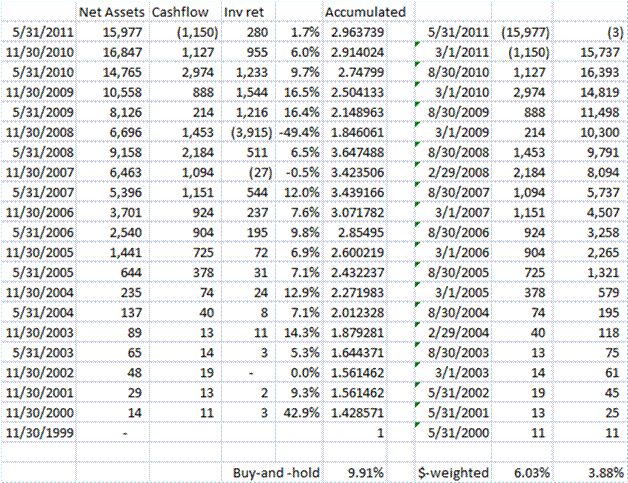The Rules, Part XLII
During a panic, it is useful to reflect on the degree to which the real economy has been driven by the financial economy.? In the Great Depression, the degree was heavy; in the seventies, it was light.? Today, my guess is that it is in-between, which makes it difficult to figure out the right strategy.
Again, this was written in 2002 or so.? As I posted last night, the banks were in relatively good shape then.? I made a lot of money for my clients buying bank floating rate trust preferred securities at ~$80.? There was no security that we did not clear at least $10 on, and most cleared $20 within a year.? One even went from $68 to $100, plus a healthy coupon.? In bond terms those were a series of home runs.? As an aside, as a bond investor, I focused more on net capital gains than most, and that helped us in a rocky era.? I often gave up current income to gain the potential for capital gains, which was the opposite of most of my competitors.
So in 2002 it was reasonable to buy banks as the willingness to supply of credit grew.? But there are limits to how much credit you can have in an economy without things getting screwy.? An economy with too many promises to pay becomes inflexible; far better to finance more of the economy with equity, but that requires a Fed that works properly, like it was under Eccles, Martin and Volcker.? Under men of less courage, like Bernanke, Greenspan, Burns, Miller, Crissinger, and Young, it simply paves the way for asset bubbles and price inflation.
In 1929 and 2008, though, it was relatively easy to know that the financial economy had grown too large for the real economy.? Total debt to GDP levels were at records.
Or think of it from this angle: in 2004, I was recruited by another financial hedge fund to be their insurance analyst.? I talked with them, but ultimately I refused, because I felt the boss was probably less competent than my current boss.? A major part of his presentation was how amazing the outperformance of financial stocks had been over the prior 10 years, implying that it would be the same over the next 10.? That outperformance was not repeatable because the capital of the banking and shadow banking industries had gotten so large that there was no longer any way that they could extract a high return out of the rest of the economy.? As it was, the effort to do so made them take on asset risks that killed many companies, and should have killed many, many more, had economic policy been handled properly.
This is one reason why my long only portfolio was so light on financials, excluding insurers, going into 2008.? I sold the last of my banks in 2007, realizing Europe would be no safe haven.? I retained one mortgage REIT that cratered as repo fell apart, teaching me a valuable lesson that I had bought something cheap, but not safe.? That was my only significant loss during the crisis starting in 2007-2008.? Repo funding is not a safe funding source during crises, and this is something that is not fixed from the last crisis, along with portfolio margining, and a few other weak liability structures.
With respect to the eras starting in 1929 and 2008, the key concept is debt deflation?? When there are too many debts, there will be too many bad debts.? That is the time to only only companies with strong balance sheets that will not need to refinance under any conditions.? That eliminates all banks and shadow banks.
I can’t guarantee that we are past the crisis, because we haven’t seen what will happen to the economy when the Fed starts to lessen policy accommodation, much less tighten.? As it is, for the most part, I not only own companies that are cheap, but primarily companies that are safe.? Value investing is “safe and cheap,” not just cheap.? This applies to financials as well, but many value investors lost a lot of money on financials because they ignored credit quality near the end of a credit boom.? Many credit-sensitive companies looked cheap near the end of the 2007, but they were cheap for a reason — they were about to get pelted by a ton of losses.
As an aside, do you know how hard it is to get a value manager to short something trading at 50% of book value?
I know how tough that is.? I’ve been through it.? He would not bite.
The company had asset risks as well as liability risks.? I extrapolated the liability cash flows to realize the long-term care? policies the company had written would likely bankrupt them.? But when the boss came to me pitching it as a long because one his buddies thought it was dirt-cheap, I uttered, “Gun to the head boss, I would tell you to short it.”? Reply: “But it’s trading at half of book value.” Me: “Book value is misstates true economic value.? Can’t say for certain, but I think this one goes out at zero.”
As it was, we did nothing, and the stock, Penn Treaty, did go out at zero. (There was one small positive out of this, I did convince the private equity arm not to fund a competitor in long-term care.)
Back to the main point.? Have a sense as to the financial economy.? This will probably only happen once in your life, but that time is crucial.? If there is a financial mania going on, move to safety, and reduce exposure to credit-sensitive financials.? It’s that simple, but to most value investors who invest in seemingly cheap financials that is a hard move.? Remember, safe comes before cheap in value investing, and that means questioning asset accrual items.? Financial companies have that in spades.



